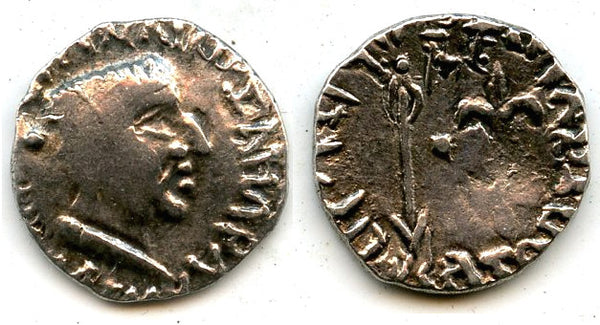
Bust of Nahapana right with collar showing, wearing a satrapal cap, corrupt Greek inscription: PANNIW SAHAPATAC NAHAPANAC / Arrow pointing downwards to the left, thunderbolt to the right, dot between them, two inscriptions one in Brahmi (Rajno Ksaharatasa Nahapanasa, reading left to right) and one in Kharoshti (Rano Ksaharatasa Nahapanasa, reading right to left). 15mm, 2.02 grams. Fishman "The Silver Coinage of the Western Satraps in India" #3.3; Mitchener 1253; Boppearachchi p.139, #3.
Nahapāna was a prominent ruler of the Western Kshatrapas (Satraps) in India during the 1st–2nd century CE, often associated with the Saka (Scythian) lineage. He ruled over a large territory in western and central India, including parts of Maharashtra, Gujarat, Malwa, and Rajasthan. Nahapāna is best known from his extensive series of silver coins and from inscriptions, particularly those found in Nasik, which document his patronage of Buddhist caves and donations by his family and ministers.
His reign marked a period of economic prosperity and active trade, as well as cultural interaction between Indian and Central Asian traditions. Nahapāna came into conflict with the powerful Satavahana king Gautamiputra Satakarni, who ultimately defeated him and reclaimed territory from the Sakas. This victory is recorded in a famous inscription by Gautamiputra’s mother at the Nasik caves. Despite his eventual defeat, Nahapāna remains a significant figure in early Indian history for his role in the political dynamics and cultural developments of the western Deccan.
